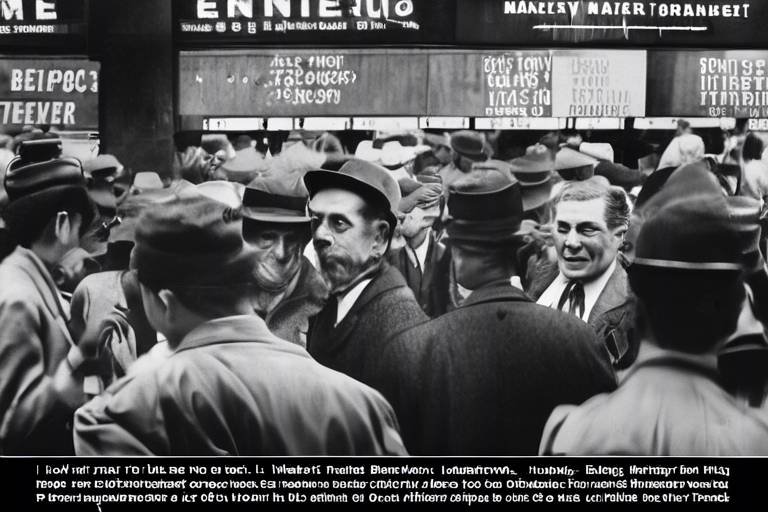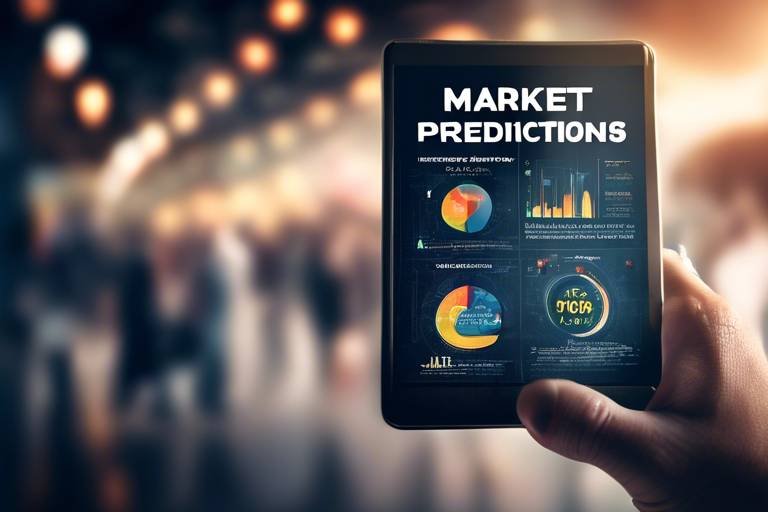Understanding Market Behavior - Lessons from Historical Trends
In the world of finance, understanding market behavior is akin to learning the language of the economy. Just as a seasoned sailor reads the winds and waves to navigate the seas, investors must analyze historical trends to chart their course in the fluctuating waters of the market. This article explores the intricacies of market behavior by examining historical trends, offering insights into economic cycles, investor psychology, and the implications for future market movements. By delving into the past, we can uncover patterns that not only inform our present decisions but also shape our expectations for the future.
Understanding market behavior requires a historical perspective. Think of it as a detective story where every clue leads to a deeper understanding of the case. Analyzing past events helps investors recognize patterns that can inform decisions and strategies in the ever-changing financial landscape. For instance, the Great Depression of the 1930s taught investors about the dangers of excessive speculation, while the dot-com bubble in the late 1990s highlighted the risks of irrational exuberance. By studying these events, investors can better prepare themselves for what lies ahead.
Economic indicators serve as vital signals for market trends. These indicators act like the heartbeat of the economy, providing insights into its overall health. Among the most significant indicators are:
- Gross Domestic Product (GDP): A measure of economic activity that reflects the total value of goods and services produced.
- Unemployment Rates: A critical indicator of economic health, as high unemployment can dampen consumer spending.
- Inflation: The rate at which prices rise, influencing purchasing power and investment strategies.
Understanding how these factors influence investor sentiment and market movements is essential for making informed decisions. For example, a rising GDP typically signals economic growth, which can lead to increased investor confidence and higher stock prices.
Investor psychology plays a crucial role in market behavior. It’s fascinating how emotions can drive decisions, often leading to trends that diverge from fundamental economic realities. Consider the concept of herd mentality, where investors follow the crowd, often resulting in market bubbles and crashes. Cognitive biases, such as overconfidence and loss aversion, can also cloud judgment. By acknowledging these psychological factors, investors can develop strategies to mitigate emotional decision-making and enhance their investment outcomes.
Historical market crashes provide valuable lessons. By analyzing notable crashes, we can identify warning signs and understand the factors that contribute to sudden market downturns. For instance, the 2008 financial crisis was precipitated by a collapse in the housing market, fueled by risky lending practices and a lack of regulatory oversight. Recognizing these patterns can help investors mitigate risks in their portfolios. Here’s a brief overview of some significant crashes:
| Year | Crash Event | Causes |
|---|---|---|
| 1929 | Great Depression | Speculation, stock market bubble |
| 2000 | Dot-com Bubble | Overvaluation of tech stocks |
| 2008 | Financial Crisis | Housing market collapse, subprime mortgages |
Government policies significantly impact market behavior. Fiscal and monetary policies shape economic conditions and investor confidence. For instance, during a recession, governments may implement stimulus packages to encourage spending, while central banks might lower interest rates to make borrowing cheaper. These actions can create ripple effects in the market, influencing everything from stock prices to consumer behavior. Understanding the interplay between government actions and market dynamics is crucial for investors looking to navigate economic cycles effectively.
Technological innovations have transformed market behavior. The rise of algorithmic trading and fintech has altered investment strategies and market dynamics. Today, traders can execute thousands of transactions in seconds, leveraging data analytics to inform their decisions. This rapid pace can create volatility, as markets react to news and trends almost instantaneously. As technology continues to evolve, investors must adapt their strategies to stay competitive in this fast-paced environment.
Differentiating between long-term and short-term trends is essential for investors. Short-term fluctuations can often be misleading, driven by temporary factors or market sentiment. In contrast, long-term trends reflect fundamental economic changes. Investors should develop strategies that account for both types of trends, ensuring their portfolios are resilient against market volatility while also capitalizing on growth opportunities.
Globalization has made markets more interconnected than ever. International events and trends can significantly influence local markets. For example, a financial crisis in one country can lead to a ripple effect, impacting economies worldwide. As such, investors must adopt a global perspective, considering how geopolitical events, trade agreements, and foreign markets can affect their investments.
Reflecting on historical trends provides essential lessons for the future. As we analyze past market behaviors, we can glean insights into potential future movements. The evolving economic landscape, characterized by rapid technological advancements and shifting consumer preferences, suggests that adaptability will be key for investors. By learning from history, we can better prepare for the challenges and opportunities that lie ahead.
Q: Why is understanding market behavior important?
A: Understanding market behavior helps investors make informed decisions, recognize patterns, and anticipate future trends based on historical data.
Q: What are key economic indicators to watch?
A: Key indicators include GDP, unemployment rates, and inflation, as they provide insights into the economy's overall health and can influence market movements.
Q: How does investor psychology affect market trends?
A: Emotions and cognitive biases can lead to irrational decision-making, causing trends that may not align with fundamental economic realities.
Q: What lessons can be learned from past market crashes?
A: Analyzing past crashes helps identify warning signs and understand the factors that contribute to downturns, allowing investors to mitigate risks in the future.

The Importance of Historical Context
When it comes to understanding market behavior, one of the most critical elements to consider is historical context. Just like a seasoned detective relies on past cases to solve new mysteries, investors must look back at historical events to identify patterns and trends that can guide their decision-making. Why is this so important? Because the financial markets are not just a chaotic jumble of numbers; they are influenced by a myriad of factors that have played out over time.
For instance, let’s take a look at the Great Depression of the 1930s. This catastrophic event reshaped the entire economic landscape and taught us valuable lessons about market psychology and investor behavior. In the aftermath, regulations were put in place to prevent similar occurrences, but the emotional scars remained. Investors became more cautious, and this caution can still be observed in today's market reactions during times of uncertainty. By understanding such historical events, we can better anticipate how current market conditions may evolve.
Moreover, historical context allows us to recognize the cyclical nature of markets. Markets tend to move in cycles—expansion, peak, contraction, and trough. Each phase has its own characteristics and investor sentiment. For example, during periods of expansion, optimism runs high, leading to increased spending and investment. Conversely, during contractions, fear often takes over, resulting in pulled investments and a more conservative approach. By studying these cycles, investors can position themselves advantageously, capitalizing on growth during expansions and safeguarding their assets during downturns.
To illustrate the significance of historical context, consider the following table that highlights key market events and their impacts:
| Year | Event | Impact on Market |
|---|---|---|
| 1929 | Stock Market Crash | Led to the Great Depression; massive sell-off |
| 2000 | Dot-com Bubble Burst | Significant decline in tech stocks; market correction |
| 2008 | Global Financial Crisis | Severe recession; loss of investor confidence |
By analyzing these events, we can glean insights into how similar situations might unfold in the future. For example, the Dot-com Bubble taught us that exuberance can lead to irrational investments, while the 2008 crisis highlighted the dangers of over-leveraging and lack of transparency in financial institutions. Each of these lessons is a piece of the puzzle that helps us understand the complex world of market behavior.
In conclusion, the importance of historical context in understanding market behavior cannot be overstated. It provides a roadmap for investors, helping them navigate the unpredictable terrain of the financial markets. By learning from the past, we can make more informed decisions today and better prepare for the challenges of tomorrow. So, the next time you're faced with a market decision, take a moment to reflect on history—your future self will thank you!

Key Economic Indicators
When it comes to understanding market behavior, economic indicators are like the compass guiding investors through the turbulent seas of financial markets. These indicators provide essential insights into the health of the economy and help investors make informed decisions. Among the myriad of indicators out there, three stand out as particularly influential: Gross Domestic Product (GDP), unemployment rates, and inflation. Each of these indicators offers a unique perspective on economic performance and can significantly impact investor sentiment.
Gross Domestic Product (GDP) is often considered the most comprehensive indicator of economic health. It reflects the total value of all goods and services produced over a specific time period. A rising GDP typically signals a growing economy, which can lead to increased consumer spending and investment. Conversely, a declining GDP can indicate a recession, causing investors to rethink their strategies. For example, during the 2008 financial crisis, the GDP saw a significant decline, which led to widespread panic in the markets.
Next, we have the unemployment rate, which measures the percentage of the labor force that is jobless and actively seeking employment. High unemployment rates can be a red flag for investors, signaling economic distress and reduced consumer spending power. On the flip side, low unemployment often correlates with a robust economy, fostering confidence among investors. For instance, during periods of low unemployment, companies may experience higher demand for their products, leading to increased profits and potentially driving stock prices up.
Inflation is another crucial indicator that investors keep a close eye on. It measures the rate at which the general level of prices for goods and services is rising, eroding purchasing power. Moderate inflation is generally seen as a sign of a healthy economy, indicating that consumers are spending and businesses are thriving. However, when inflation rises too quickly, it can lead to higher interest rates, which can stifle economic growth and negatively impact market performance. The Federal Reserve often adjusts monetary policy in response to inflation trends, further influencing market dynamics.
To illustrate the interplay between these indicators, let’s take a look at the following table:
| Indicator | Impact on Market | Current Trend |
|---|---|---|
| GDP | Rising GDP boosts investor confidence; declining GDP can lead to market downturns. | Increasing |
| Unemployment Rate | Low unemployment fosters consumer spending; high unemployment signals economic trouble. | Decreasing |
| Inflation | Moderate inflation is good; high inflation may lead to increased interest rates and market volatility. | Stable |
Understanding these key economic indicators is essential for any investor looking to navigate the complex world of finance. They serve as vital signals that can help predict market movements and inform investment strategies. By keeping an eye on GDP, unemployment rates, and inflation, investors can better position themselves to seize opportunities and mitigate risks in an ever-changing economic landscape.
As we delve deeper into the nuances of market behavior, it's clear that these indicators not only reflect the current state of the economy but also shape the future. So, the next time you hear about GDP growth or changes in unemployment rates, remember that these figures are more than just numbers; they are the heartbeat of the economy, influencing decisions at every level.
- What is GDP and why is it important?
GDP measures the economic performance of a country, indicating its overall health. - How does unemployment affect the economy?
High unemployment can lead to reduced consumer spending, negatively impacting economic growth. - What role does inflation play in investment decisions?
Inflation affects purchasing power and can influence interest rates, impacting investment returns.

Investor Psychology and Market Trends
Investor psychology is a fascinating aspect of market behavior that often gets overlooked, yet it plays an enormous role in shaping market trends. When it comes to investing, decisions are not always rooted in cold, hard data; rather, they are frequently influenced by emotions and cognitive biases. Think about it: have you ever made a purchase based on a fleeting feeling rather than a well-thought-out plan? That's exactly what happens in the stock market, where fear and greed can drive prices to extremes.
To illustrate this point, let's consider a classic scenario: during a bull market, investors often become overly optimistic, leading to a phenomenon known as herding behavior. This is when individuals follow the crowd, buying stocks simply because everyone else is doing it. The excitement can create a bubble, where stock prices soar beyond their intrinsic value. Conversely, during a bear market, the mood shifts dramatically. Panic sets in, causing investors to sell off their holdings in a frenzy, often at a loss. This reaction can exacerbate market declines, creating a vicious cycle of fear.
Another important aspect of investor psychology is the impact of cognitive biases. These are mental shortcuts that can lead to errors in judgment. For instance, the anchoring effect occurs when investors cling to an initial piece of information, such as a stock’s past price, which can skew their perception of its current value. Similarly, the confirmation bias leads investors to seek out information that supports their existing beliefs while ignoring contradictory evidence. These biases can create significant discrepancies between market behavior and underlying economic fundamentals.
Understanding these psychological factors is crucial for investors. By recognizing how emotions and biases influence decisions, one can develop strategies to mitigate their effects. For example, maintaining a disciplined investment approach and sticking to a well-researched plan can help counteract impulsive decisions driven by market sentiment. Additionally, diversifying a portfolio can act as a buffer against the emotional rollercoaster of investing, providing a more stable foundation during times of market volatility.
In summary, investor psychology is a powerful force that shapes market trends. By acknowledging the emotional and cognitive factors at play, investors can better navigate the complexities of the financial landscape. As we continue to explore market behavior, it becomes clear that understanding the mind of the investor is just as important as understanding the numbers.
- What is investor psychology? Investor psychology refers to the emotional and cognitive factors that influence investors' decisions and behaviors in the financial markets.
- How do emotions affect investing? Emotions like fear and greed can lead to irrational decision-making, causing investors to buy high during euphoria or sell low during panic.
- What are cognitive biases? Cognitive biases are systematic patterns of deviation from norm or rationality in judgment, which can affect investment decisions.
- How can I mitigate the effects of investor psychology? Maintaining a disciplined investment strategy, diversifying your portfolio, and being aware of your own biases can help mitigate emotional decision-making.

Case Studies of Market Crashes
When we talk about market crashes, we're diving into some of the most tumultuous times in financial history. These events not only shake investor confidence but also serve as critical learning moments. Think about the infamous Great Depression of 1929. It was a cataclysmic event that sent shockwaves through the global economy, leading to massive unemployment and a significant decline in consumer spending. The stock market lost nearly 90% of its value from its peak, and it took over a decade for it to fully recover. Understanding the factors that led to this crash can help investors today recognize similar patterns that might signal impending downturns.
Another notable example is the Dot-Com Bubble of the late 1990s. Fueled by the rise of the internet, investors poured money into tech stocks, often without considering the underlying business fundamentals. When the bubble burst in 2000, the NASDAQ Composite index plummeted by almost 78% from its peak. This crash highlighted the dangers of speculative investing and the importance of due diligence. Investors learned that just because a company has a catchy name or a promising technology doesn't mean it will be profitable.
More recently, the 2008 Financial Crisis serves as a stark reminder of how interconnected global markets can be. Triggered by the collapse of the housing market in the United States, this crisis led to the failure of major financial institutions and a severe credit crunch. The S&P 500 index lost around 57% of its value from 2007 to 2009. One of the key takeaways from this event is the importance of understanding leverage and risk management. Investors learned that excessive borrowing can amplify losses and lead to catastrophic outcomes when markets turn sour.
To further illustrate the impact of these market crashes, let's take a look at a comparative table of these notable events:
| Market Crash | Year | Peak Loss | Key Lesson |
|---|---|---|---|
| Great Depression | 1929 | 90% | Importance of economic fundamentals |
| Dot-Com Bubble | 2000 | 78% | Beware of speculative investing |
| 2008 Financial Crisis | 2008 | 57% | Understand leverage and risk |
These case studies remind us that while market crashes can be devastating, they also offer invaluable lessons. By studying past events, investors can develop a more resilient mindset and better strategies for navigating future market volatility. It's like learning to ride a bike; you might fall a few times, but each tumble teaches you how to balance better and avoid the same mistakes. So, the next time you hear about a market downturn, remember the lessons from history and keep your eyes peeled for those warning signs.
As we reflect on these historical trends, it's crucial to remain vigilant and informed. The financial landscape is always evolving, and understanding how past events shape current market behavior can provide a roadmap for future success. So, buckle up and stay curious; the world of investing is full of surprises!
- What is a market crash? A market crash is a sudden and significant decline in the value of financial markets, often triggered by panic selling and economic downturns.
- How can I protect my investments during a market crash? Diversification, maintaining a cash reserve, and having a long-term investment strategy can help mitigate risks during market downturns.
- Are market crashes predictable? While some indicators can signal potential downturns, predicting the exact timing and severity of market crashes is challenging.

The Role of Government Policies
Government policies are like the invisible hand guiding the economy, shaping the environment in which markets operate. These policies can be broadly categorized into two main types: fiscal policies and monetary policies. Fiscal policies involve government spending and tax policies, while monetary policies are primarily concerned with the management of money supply and interest rates by central banks. Together, they play a crucial role in influencing market behavior, investor confidence, and overall economic stability.
When governments implement expansionary fiscal policies, such as increasing spending or cutting taxes, they aim to stimulate economic growth. This can lead to a surge in consumer spending, which in turn boosts corporate earnings. However, if these policies lead to excessive spending without corresponding revenue, they can also result in increased national debt and inflationary pressures. Conversely, contractionary policies, which involve reducing spending or increasing taxes, can cool down an overheated economy but may also stifle growth and lead to higher unemployment rates.
On the other hand, monetary policies, often enacted by central banks like the Federal Reserve in the United States, have a profound impact on market behavior. For instance, when a central bank lowers interest rates, borrowing becomes cheaper, encouraging businesses and consumers to take loans for investment and spending. This can lead to increased economic activity and, ultimately, higher stock market valuations. However, if interest rates are kept too low for too long, it can lead to asset bubbles, where the prices of stocks or real estate inflate beyond their intrinsic values.
To illustrate the impact of government policies on market behavior, consider the following table that summarizes key fiscal and monetary actions and their potential effects on the economy:
| Policy Type | Action | Potential Effect |
|---|---|---|
| Fiscal Policy | Increase in Government Spending | Stimulates economic growth; increases demand |
| Fiscal Policy | Tax Cuts | Increases disposable income; boosts consumer spending |
| Monetary Policy | Lowering Interest Rates | Encourages borrowing; stimulates investment |
| Monetary Policy | Quantitative Easing | Increases money supply; lowers long-term interest rates |
It's important to note that government policies do not operate in a vacuum. They interact with various economic factors, including global events, market sentiment, and technological advancements. For instance, during the COVID-19 pandemic, governments worldwide implemented aggressive fiscal and monetary measures to mitigate the economic fallout. These actions included direct payments to citizens, loans to businesses, and significant interest rate cuts. The result was a rapid recovery in markets, showcasing how effective policy responses can stabilize and even invigorate economic activity.
Understanding the role of government policies is essential for investors. By keeping an eye on policy changes and their implications, investors can make more informed decisions and anticipate potential market movements. For example, if a government signals a shift towards tighter monetary policy, savvy investors might adjust their portfolios in anticipation of rising interest rates, which could negatively impact sectors like real estate or utilities.
In conclusion, government policies are pivotal in shaping market dynamics. They can either foster growth or create obstacles, depending on how they are implemented and the broader economic context. As we move forward, staying attuned to these policies will be crucial for anyone looking to navigate the complexities of the financial markets.

Technological Advancements and Market Dynamics
In today's fast-paced financial world, technological advancements are not just a luxury; they are a necessity. The rise of the internet, mobile applications, and sophisticated algorithms has revolutionized how we think about investing and market behavior. Imagine a world where trades are executed in milliseconds, and data analytics can predict market trends with remarkable accuracy. This is the new reality, and it's reshaping the landscape of investing.
One of the most significant changes brought about by technology is the advent of algorithmic trading. This method uses complex algorithms to execute trades at speeds and volumes that are impossible for human traders. As a result, markets have become more efficient, but they also exhibit increased volatility. When algorithms react to market signals, they can create rapid price swings that are often disconnected from underlying economic fundamentals. This phenomenon raises the question: are we witnessing a new era of market dynamics driven by technology?
Moreover, technological innovations have democratized access to financial markets. Retail investors, once limited by high fees and lack of information, now have tools at their fingertips that allow them to trade like professionals. Platforms like Robinhood and E*TRADE provide user-friendly interfaces and commission-free trading, enabling a surge of new investors to enter the market. This influx of retail investors can lead to dramatic shifts in market behavior, as seen with the recent GameStop saga. The collective power of individual investors, fueled by social media and online forums, can significantly influence stock prices, demonstrating the profound impact of technology on market dynamics.
Another crucial aspect to consider is the role of fintech companies. These firms are leveraging technology to provide innovative financial services, from robo-advisors to peer-to-peer lending. They are not just changing how we invest; they are redefining the entire financial ecosystem. For example, robo-advisors use algorithms to create and manage investment portfolios based on individual risk tolerance and financial goals. This shift towards automation raises important questions about the future of traditional financial advisors and the nature of personalized investment strategies.
To illustrate the impact of technology on market dynamics, let's take a look at some key trends:
| Trend | Description | Impact on Market |
|---|---|---|
| Algorithmic Trading | Automated trading strategies executed by algorithms. | Increased market efficiency and volatility. |
| Access to Information | Real-time data and analytics available to all investors. | Empowered retail investors and informed decision-making. |
| Robo-Advisors | Automated investment management services. | Lower costs and increased accessibility to investment advice. |
However, while technology can enhance investment strategies, it also introduces new risks. The reliance on algorithms can lead to systemic issues, especially during periods of market stress. Flash crashes, where stock prices plummet within minutes due to automated trading, highlight the potential dangers of a tech-driven market. As investors, we must remain vigilant and consider how these technological advancements can both benefit and challenge us.
In conclusion, the interplay between technology and market dynamics is a double-edged sword. On one hand, it opens up new opportunities and democratizes investing; on the other, it can lead to unforeseen risks and volatility. As we navigate this evolving landscape, understanding the implications of technological advancements will be crucial for making informed investment decisions.
- How has technology changed the way we invest? Technology has introduced tools like algorithmic trading and robo-advisors, making investing more accessible and efficient.
- What are the risks associated with algorithmic trading? Algorithmic trading can lead to increased volatility and systemic risks, especially during market downturns.
- Are retail investors influencing the market more than before? Yes, the rise of trading platforms has empowered retail investors to significantly impact market movements, as seen in recent events.

Long-Term vs. Short-Term Trends
When it comes to investing, understanding the difference between long-term and short-term trends is crucial. Think of it like comparing a marathon to a sprint: while both require strategy and stamina, the approaches and mindsets differ significantly. Long-term trends are often driven by fundamental changes in the economy, technology, and consumer behavior, while short-term trends can be influenced by market sentiment, news events, or even social media buzz. Recognizing these distinctions can help investors navigate the complexities of market behavior more effectively.
Long-term investing typically involves holding assets for several years, allowing for growth and compounding returns. This approach is grounded in the belief that, despite short-term fluctuations, the market tends to rise over time. Investors who adopt a long-term strategy often focus on fundamentals such as company earnings, economic indicators, and industry trends. For instance, consider a tech company that consistently innovates and expands its market share; over the years, its stock price is likely to reflect its underlying growth, despite occasional dips due to market volatility.
On the flip side, short-term trends can be much more volatile and unpredictable. These trends are often driven by immediate factors like earnings reports, geopolitical events, or changes in consumer sentiment. Investors who engage in short-term trading, such as day trading or swing trading, typically rely on technical analysis and market indicators to make quick decisions. For example, a sudden news release about a product recall might lead to a sharp decline in a company's stock price, presenting a short-term trading opportunity for those who can act swiftly.
While both strategies have their merits, they also come with distinct risks. Long-term investors may face the challenge of market downturns that can temporarily erode their portfolios, but historically, they have the advantage of time on their side. Conversely, short-term traders may capitalize on quick gains but risk significant losses if they misinterpret market signals or act impulsively. Understanding one’s risk tolerance and investment goals is essential when deciding between these approaches.
To illustrate the differences further, consider the following table that summarizes key aspects of long-term and short-term investing:
| Aspect | Long-Term Trends | Short-Term Trends |
|---|---|---|
| Investment Horizon | Years to decades | Days to months |
| Focus | Fundamentals and growth | Market sentiment and volatility |
| Risk Level | Generally lower | Generally higher |
| Strategy | Buy and hold | Active trading |
| Returns | Compounding over time | Quick profits or losses |
Ultimately, the choice between long-term and short-term investing should align with your financial goals and personal circumstances. Are you looking for steady growth, or do you thrive on the thrill of quick trades? Each approach requires a different mindset and strategy, but both can coexist in a well-rounded investment portfolio. By understanding these trends, investors can make informed decisions that suit their unique situations.
- What is the best strategy for beginners? Many experts recommend starting with a long-term investing strategy to build a solid foundation.
- Can I combine both long-term and short-term investing? Absolutely! Many investors diversify their portfolios by incorporating both strategies.
- How do I know when to sell? This depends on your investment strategy; long-term investors might hold through fluctuations, while short-term traders may sell quickly to capitalize on gains.

Globalization and Market Interconnectivity
In today's world, globalization has become a buzzword that resonates across various sectors, especially in finance. It refers to the increasing interconnectedness of economies, cultures, and populations, driven by trade, investment, and technology. This phenomenon has dramatically reshaped market behavior, making it essential for investors to understand the implications of global events on local markets. Imagine a vast web where each thread represents a different market; when one thread shakes, the entire web feels the tremors. This interconnectedness means that a financial crisis in one part of the world can ripple through to affect markets thousands of miles away.
One of the primary drivers of this interconnectivity is the advancement of technology. With the rise of the internet and digital communication, information flows faster than ever before. Investors can now access real-time data from global markets, allowing them to make quicker decisions. However, this speed can also lead to heightened volatility. For instance, news of a political crisis in one country can trigger immediate sell-offs in another, as investors react to perceived risks. The 2008 financial crisis is a prime example of how interconnected markets can amplify problems. It started in the U.S. housing market but quickly spread to Europe and beyond, demonstrating the fragility of our global financial system.
Additionally, trade agreements and international partnerships have further woven together the fabric of global markets. Countries are no longer isolated; they depend on each other for goods, services, and capital. This reliance means that changes in trade policies—such as tariffs or sanctions—can significantly impact market behavior. For example, when the U.S. imposed tariffs on Chinese goods, it not only affected trade between the two nations but also had repercussions for markets around the globe. Companies that relied on materials from China faced increased costs, leading to a ripple effect on stock prices and investor sentiment worldwide.
Moreover, the rise of multinational corporations has added another layer to this complexity. These companies operate across borders, with supply chains that span continents. When they face challenges—be it regulatory changes in one country or natural disasters in another—the effects can be felt across their global operations. For instance, a factory shutdown in Asia due to a natural disaster can disrupt production schedules and financial performance in Europe and North America, leading to stock market fluctuations.
To better illustrate the impact of globalization on market interconnectivity, consider the following table that highlights key factors and their effects:
| Factor | Effect on Markets |
|---|---|
| Political Instability | Increased volatility and risk aversion among investors. |
| Trade Agreements | Can enhance market confidence or lead to uncertainty depending on the terms. |
| Technological Advancements | Facilitates faster information flow, impacting trading behaviors. |
| Economic Indicators | Global indicators (like oil prices) can sway local market trends. |
Understanding these dynamics is crucial for investors. It’s not just about analyzing local market conditions anymore; it’s about being aware of global trends and events. As such, a savvy investor should keep an eye on international news and how it may impact their investments. Being proactive rather than reactive can make a significant difference in navigating the complexities of today’s markets.
In conclusion, globalization has transformed the financial landscape into a highly interconnected arena. Investors must adapt to this reality by broadening their perspectives and strategies. The world is not just a collection of isolated markets; it’s a complex, interwoven tapestry where each thread influences the other. By understanding these connections, investors can make more informed decisions and better prepare for the uncertainties that lie ahead.
- How does globalization affect local markets? Globalization increases interdependence among markets, meaning local events can have far-reaching effects.
- What role does technology play in market interconnectivity? Technology facilitates faster communication and information sharing, which can lead to rapid market reactions.
- Can a crisis in one country impact global markets? Yes, financial crises can ripple through interconnected markets, affecting investor confidence and market stability worldwide.
- What should investors consider in a globalized market? Investors should keep an eye on international news, trade policies, and global economic indicators to make informed decisions.

Lessons Learned and Future Outlook
Reflecting on historical trends is not just a nostalgic exercise; it’s a critical part of understanding how future markets may behave. The lessons gleaned from past market behaviors can serve as a compass for investors navigating the often turbulent waters of the financial landscape. For instance, one of the most significant takeaways from previous market cycles is the importance of diversification. Investors who spread their assets across various sectors tend to weather downturns more effectively than those who concentrate their investments in one area. This principle has been evident during numerous market crashes, where sectors such as technology or real estate have experienced dramatic fluctuations.
Moreover, understanding the cyclical nature of economies is vital. Historical data shows that markets often go through cycles of expansion and contraction. Recognizing these patterns can help investors anticipate potential downturns. For example, during periods of economic expansion, it’s common to see rising inflation and interest rates. Investors who pay attention to these indicators often reposition their portfolios to mitigate risks associated with an impending slowdown.
Another critical lesson is the impact of investor sentiment on market behavior. The emotional responses of investors can lead to irrational market movements, often disconnected from fundamental economic realities. This phenomenon was notably observed during the dot-com bubble of the late 1990s and the housing market crash in 2008. In both instances, exuberance led to inflated asset prices, which eventually corrected sharply. As such, maintaining a level-headed approach and relying on data rather than emotions can be a game changer for investors.
Looking forward, the evolving economic landscape presents both challenges and opportunities. The rise of technology, particularly in the realm of fintech, is reshaping how investments are made and managed. Algorithmic trading and artificial intelligence are becoming increasingly prevalent, allowing for quicker and more informed trading decisions. However, this also introduces new risks, as markets can react rapidly to technological changes or cyber threats. Investors must stay informed and adapt their strategies accordingly.
Furthermore, globalization has created a more interconnected market environment. Events in one part of the world can have ripple effects across the globe. For instance, a political upheaval in a major economy can influence stock prices and investor confidence worldwide. Therefore, maintaining a global perspective is crucial for investors aiming to make informed decisions in this interconnected market.
In conclusion, the lessons learned from historical market trends are invaluable for shaping future investment strategies. By embracing diversification, understanding economic cycles, managing investor sentiment, and adapting to technological advancements and globalization, investors can better position themselves for success. The future may hold uncertainties, but with the right insights and strategies, navigating the financial markets can be a rewarding endeavor.
- What are the key lessons learned from past market trends?
Key lessons include the importance of diversification, understanding economic cycles, and managing investor sentiment. - How can technology impact market behavior?
Technological advancements, like algorithmic trading, can lead to quicker trading decisions but also introduce new risks. - Why is a global perspective important for investors?
Globalization means that events in one region can significantly affect markets elsewhere, making it essential for investors to stay informed about international developments.
Frequently Asked Questions
- What are the key economic indicators to watch for market trends?
Key economic indicators include Gross Domestic Product (GDP), unemployment rates, inflation rates, and consumer confidence indexes. These indicators provide insights into the health of the economy and can significantly influence investor sentiment and market movements.
- How does investor psychology impact market behavior?
Investor psychology is a powerful force in the market. Emotions such as fear and greed can lead to irrational decision-making, causing trends that may not align with fundamental economic realities. Understanding these psychological factors can help investors make more informed decisions.
- What lessons can be learned from historical market crashes?
Historical market crashes teach us to recognize warning signs, such as excessive speculation and overvaluation. By studying past downturns, investors can develop strategies to mitigate risks and avoid repeating mistakes from the past.
- How do government policies affect market behavior?
Government policies, including fiscal and monetary measures, have a profound impact on economic conditions and investor confidence. For example, interest rate changes can influence borrowing costs and spending, ultimately shaping market trends.
- What role does technology play in market dynamics?
Technological advancements, such as algorithmic trading and fintech innovations, have transformed how investors engage with the market. These technologies can enhance trading efficiency but also introduce new risks and volatility.
- How can investors differentiate between long-term and short-term trends?
Investors can differentiate between long-term and short-term trends by analyzing market cycles and economic indicators. Long-term trends often reflect fundamental economic changes, while short-term trends may be influenced by market sentiment or news events.
- Why is globalization important for understanding market behavior?
Globalization has interconnected markets worldwide, meaning that international events can significantly impact local markets. Investors must consider global trends and economic conditions to make well-informed investment decisions.
- What insights can we gain about future market behavior from historical trends?
By reflecting on historical trends, investors can identify patterns that may repeat in the future. Understanding these patterns, alongside current economic conditions, can provide valuable insights into potential future market movements.



















